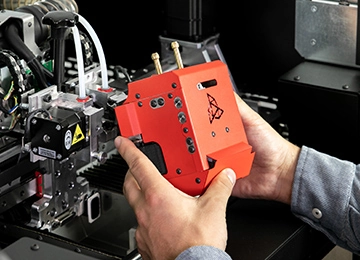Manual
Software
Useful terms
3DGENCE SLICER
-
G-code
This is a normalized programming language adjusted to control CAM machines. In simple words, the G-code string includes machine instructions – in what direction, how fast and along which axis to move. The code for printers is generated by slicing software (slicers). It stores all the data on subassembly temperatures and the revs of motors in a precision sequence that results in moving the hotend and defines the extruder behavior. The code commands are sent line by line to the printer controller processor during the printing process. The processor interprets the code based on its software and sends specific signals to particular components.
-
HIPS
High-Impact Polystyrene – a styrene polymer. It is used mainly in 3D printing as a material for printing support structures for ABS plastic. It is soluble in d-limonene. It features a high impact resistance and a low flexibility.
-
Knurl
This is an extruder part, driven by a stepper motor. It makes it possible to accurately feed the plastic wire to the printer nozzle thanks to its concave, “toothed/knurled” recess that “bites” into the plastic wire. An element that strictly cooperates with the knurl is the clamp providing a correct contact between the knurl and the filament.
-
Nozzle
A head component coming into direct contact with the print. The nozzle heated to temperature specific for a material makes it flow and forms a thread of plastic with a rated nozzle diameter. The 3DGence ONE printer as standard is equipped with a 0.4 mm nozzle. The nozzle outlet diameter affects the available resolutions, print speed and accuracy.
-
Nylon
A group of polyamide materials developed by DuPont company. Currently, these are used also for producing resistant filaments for 3D prints. Its main advantage includes its high mechanical and chemical strength, possibility of further processing and coloring with textile dyes. Prints feature also some flexibility and resistance to rupture.
-
OBJ
This is a popular format of 3D files. It may contain an additional MTL (Material Template Library) file irrelevant for FFF print, containing information on material libraries defined for the model. OBJ files apart from the geometry description, apex layout and normal orientations includes information on UV coordinates for textures. It is read by the 3DGence Slicer program.
-
Overhang
This is a shape of the part of a model with special significance from the point of FFF printing. An overhang can be found where a model plane forms an overhang over the working table or other model part. The 3DGence Slicer software identifies those areas and analyzes the overhang angle in relation to the working table. If the angle exceeds the value of limit angle predefined in the software, the 3DGence Slicer program automatically generates support structures for such a surface.
-
PLA
Polylactide – a lactic acid polymer – produced in industrial quantities with use of eco-friendly methods. The main sources for initial materials include grains, e.g. cornflour or bacterial cultures. This is a basic material for FFF technology 3D printing. Low costs, no thermal shrinkage, good adhesion to the bed and multiple filler and color variants make the PLA the most versatile and most commonly used filament. During printing it gives off a weak, neutral odor, does not emit harmful substances and is fully biodegradable. It is more fragile and susceptible to mechanical damage than ABS, that’s why its use to manufacture the prototypes of mechanical devices is limited.
-
PVA
Polyvinyl alcohol – a water soluble vinyl alcohol polymer. It is used to produce water-soluble filaments, perfectly suitable for printing support structures in dual-material printing. The model itself is printed with an insoluble plastic (the most commonly with PLA), which allows for its accurate cleaning in water bath. Using an ultrasound washer results in significant acceleration of the process.
-
Raft
One of the methods of enhancing print adhesion to the working table. The raft is the base (bed) with a thickness of a few alternately applied layers that is generated by the slicer under the model. The raft is larger than model outline, which increases print adhesion to the table and prevents from thermal shrinkage effects (plastic to plastic connection). Another advantage of the raft is its capacity to smooth minor uneven areas of the working table. The raft makes it also easier to print models without a flat surface that could make a base. Brim and the raft should not be used simultaneously.

